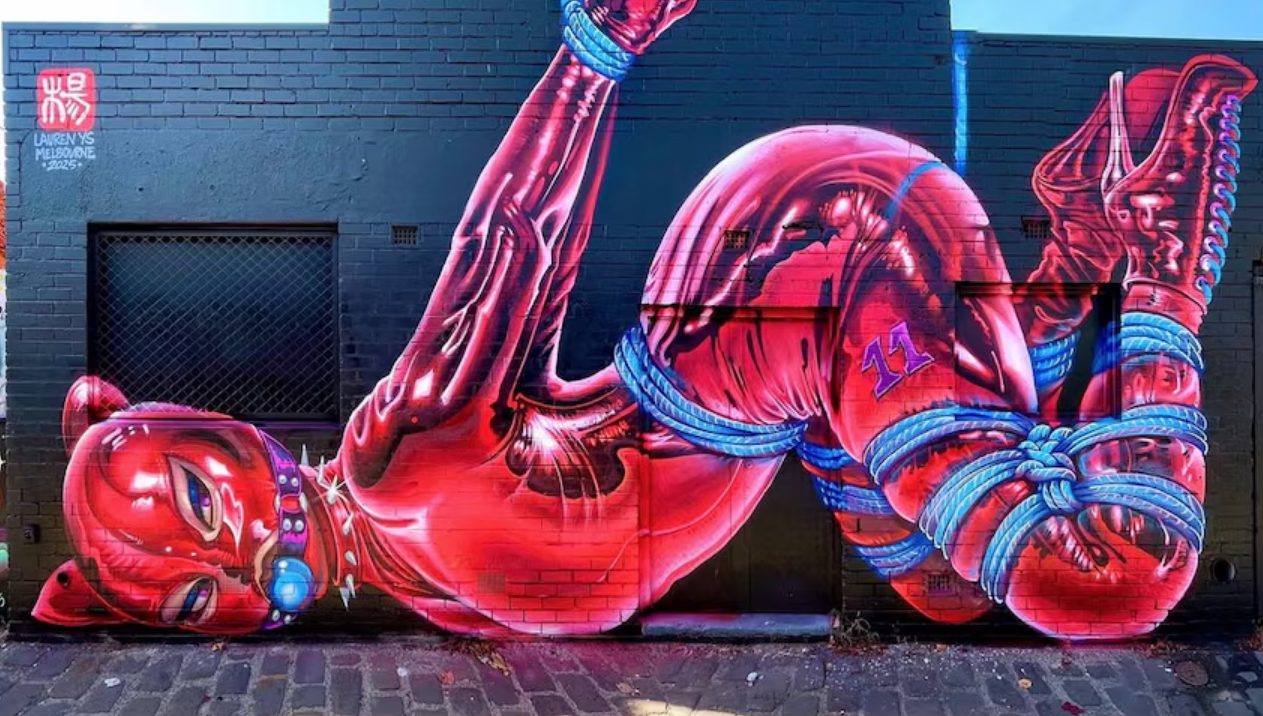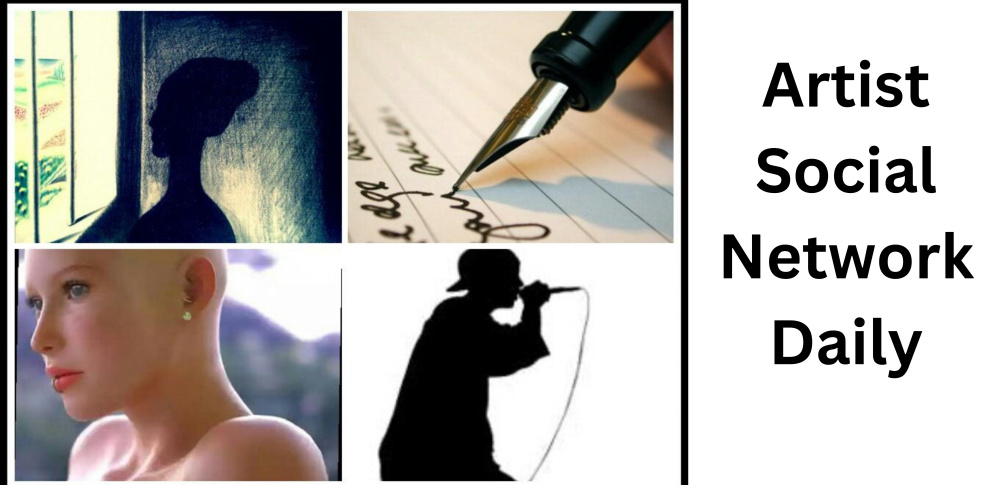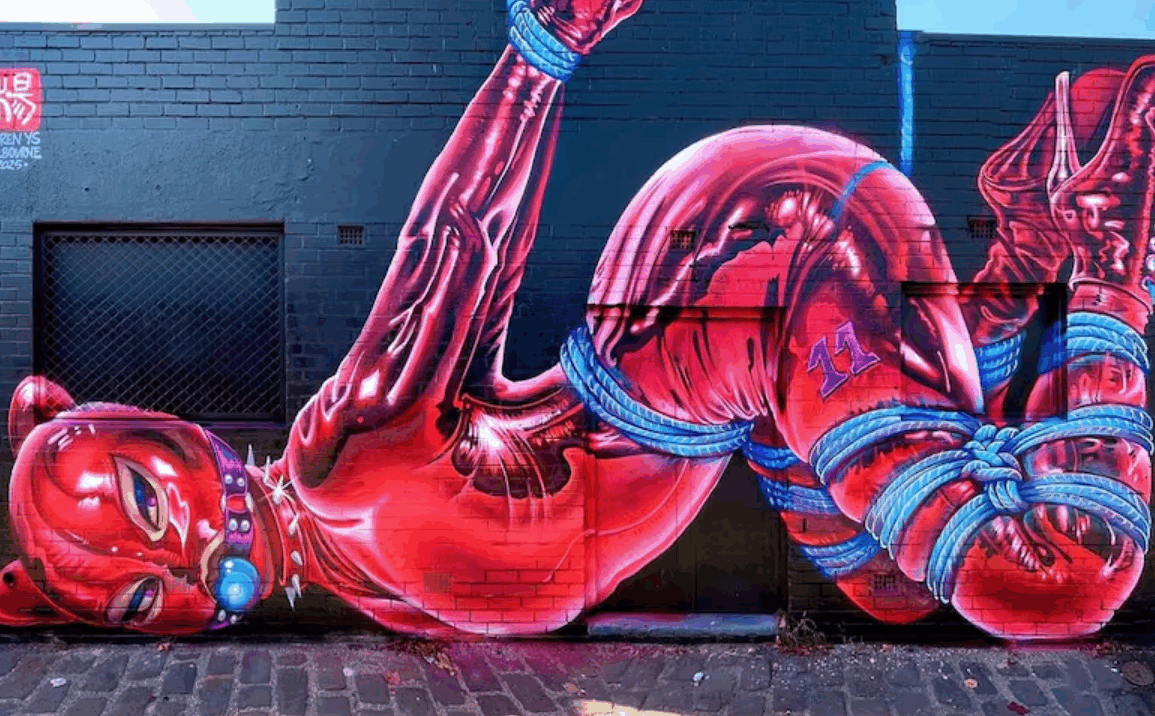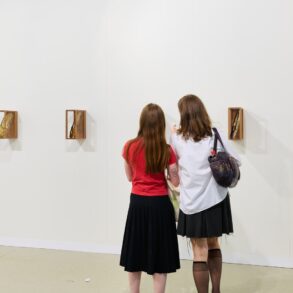
A mural in Fitzroy, Melbourne, depicting a bound and gagged woman PHOTO: Instagram via ABC News
Every day we are bombarded with messages that degrade women. Sexualised images of women are used to attract attention to advertising, news stories, social media accounts, pop culture, TV shows and pretty much anything else you can possibly imagine. You only have to think of Bianca Censori attending the Grammys as Kanye West’s virtually naked accessory to appreciate how ingrained into celebrity culture the objectification of women is. Meanwhile, the spread and mainstreaming of horrifically sexist pornography and the sex industry is normalising violent sexual practices and the dehumanisation of women.
So imagine an artist is given a whole wall to make a statement, free from corporate influence, and the thing they choose to do is to add yet another demeaning, objectifying image of women to the world. This is exactly what happened in the Melbourne suburb of Fitzroy, where a mural was recently installed depicting a bound and gagged female body in stilettos, a studded dog collar and cat ears. Rightly, the mural has been denounced by anti-violence group Collective Shout as “a chilling image of eroticised violence against women”. Many members of the public have likewise registered their outrage in emails to the council. And fair enough—are women entitled to no relief from this unrelenting reminder that we only have value when we’re being debased for the pleasure of someone else?
The artist responsible for the mural, Los Angeles-based Lauren YS, responded to the criticism by saying that “anyone imposing negative narratives onto it is incorrectly assuming its meaning”. They claim it is a piece about “empowerment and queer selfhood”. A local man speaking to the ABC defended the work on the basis that it is “representing a culture that a lot of people don’t know about, shibari (Japanese rope bondage) is a beautiful art-form that brings intimacy in people”. Apparently, violence against women, when it is a reference to Japanese culture or a form of queer expression, is different to other misogynistic images. But why? If Andrew Tate were to claim that his interest in abusing women was a queer fetish with allusions to feudal customs would that make it ok?
The refusal to engage with the idea that the mural might be sexist even extended to progressive Yarra mayor Steve Jolly. When asked about it, Jolly chose not to comment on the content of the image, citing his main concern as the potential breach of council by-laws.
Most of the media reporting about the mural has focussed on its location on a public street where children might see it, and the appropriateness of exposing children to sexually explicit content. But this misses the point. Whether its children or adults exposed to it, the problem is the acceptance of the dehumanisation of women as legitimate sexual activity, in the context of a society in which women are oppressed and already subject to unacceptably high levels of violence, often deadly violence. How can we wring our hands at every news report of another woman killed by a man at the same time as every conceivable available space is saturated with images that erotise such violence to make money and, even worse, elevate it to art?
There is no denying the connection between the demeaning portrayal of women in advertising, pop-culture and pornography and abuse in the real world. A 2023 report by a French equality watchdog found that 90 percent of online pornography involved verbal, physical and sexual violence against women. Higher levels of consumption of porn correlate with men holding more derogatory attitudes towards women. Acts like choking, commonly depicted in porn, have become more mainstream with 61 percent of women, and 79 percent of trans and gender diverse people aged 18 to 35 reporting that they have been strangled during sex. Sexual assault is also increasing among young people, with 28 percent of men between 18 and 30 reporting using at least one form of physical or sexual violence against a partner. And, abhorrently, sexist attitudes among young men are on the rise.
Too often today, objections to sexist objectification and the normalisation of porn are dismissed as prudery, and support for it sold as “sex positivity”. But objecting to demeaning portrayals of women is not anti-sex. Sex is not synonymous with degrading other people. That young women and queer people are today exhorted to release their inner porn star, love kink and BDSM, and even see violence against (almost always) female bodies as “empowering” does not make these practices liberating. Rather, it is a victory for the sex and pornography industries, which are the main beneficiaries of the mainstreaming of violent or non-consensual sex as pleasurable.
The acceptance of depictions of violence when they are sexualised points to a glaring cultural hypocrisy. If this mural had glamorised a woman being violently restrained in a police cell or lying unconscious on the kitchen floor after being assaulted by her partner, or being stalked by an ex, it would not have been seen as progressive or appropriate for public display. Similarly, if the figure in the mural had been a man, the meaning of the mural would be completely different. This double standard is a product of sexism—violence is not ok, unless it’s for someone’s sexual gratification and is being directed at a woman.
Anti-sexists have a responsibility to resist this and to stand up for a world in which human interactions are first and foremost about equality and mutual respect, not degradation and dehumanisation. When I first got involved with activism, feminists and leftists would never have embraced such filth. Women have for a long time been subjected to demeaning stereotypes in popular culture. These things used to be met with hostile eye rolling, culture jamming or protest. Today, it is self-described activists and leftists who are embracing sexist symbols and tropes, or refusing to criticise them on an anti-sexist basis. Those of us who want to see a world of genuine liberation need to stand against this reactionary tide, to assert our right to be socially equal and sexually free.
This post was originally published on this site be sure to check out more of their content








